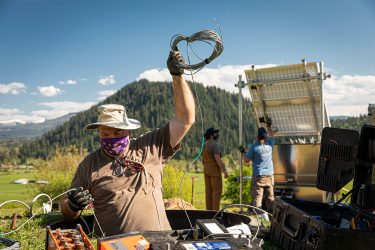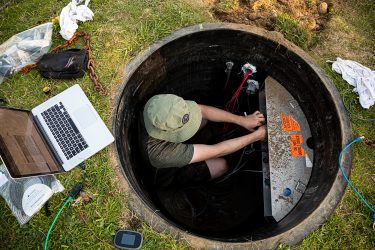
As people and organizations across the globe practice earthquake drills Oct. 19 on International ShakeOut Day, closer to home in the Pacific Northwest, communities are bolstered by a state-of-the-art earthquake early warning system — and a research center that maintains the second-largest seismic network in the U.S.
The Pacific Northwest Seismic Network, housed within the UW College of the Environment, collects data from more than 700 seismic stations across Washington and Oregon, plus data from partner organizations in British Columbia and bordering states. As data continuously feeds into computers housed at the University of Washington, ShakeAlert algorithms can detect an earthquake event that could be damaging. If the earthquake meets a certain threshold, an alert goes out across cell phones and critical infrastructure like hospitals and water utilities to prepare for the shaking. A warning of even a few seconds can make a huge difference.
“When you get a message even just a couple of seconds before the shaking starts, your brain has a moment to process what’s happening,” said Harold Tobin, director of the PNSN and a UW professor of Earth and space sciences. “With a few seconds of warning, various industrial processes also can be halted or mitigated. Surgeries can be paused, and light rail trains could stop moving or not roll onto that next bridge.”
Practicing how to protect yourself during an earthquake is key to a quick, safe response should an earthquake alert sound. At 10:19 a.m. on Oct. 19, Washington residents and organizations are encouraged to drop, cover and hold on in a practice earthquake safety drill. Several UW-based units, including Emergency Management, are participating in the drill. PNSN supports this effort through earthquake awareness and outreach, and by providing the latest science on earthquakes in our region.

And since it launched in 2021 in Washington, ShakeAlert — a collaboration between the U.S. Geological Survey, UW and universities in Oregon and California — now provides the entire West Coast with advanced warning of an earthquake about to hit.
“The network is very close to being completely built out for ShakeAlert’s design plan and we’re really happy with its performance,” Tobin said. “We’ll continue to upgrade our network and make it better, faster and more resilient.”
Last week’s 4.3 magnitude earthquake south of Port Townsend is a good example of the ShakeAlert system functioning well, Tobin explained. Within two or three seconds after first detecting the earthquake, the system determined it wouldn’t produce enough shaking to warrant an alert for the general public.
“This process was invisible to the general public, but ShakeAlert actually performed extremely well in this event,” he said.
That earthquake, felt widely throughout Puget Sound, perhaps was a reminder to some that we live in an earthquake-prone region. Experts say it’s important to take steps to prepare for when a big earthquake hits, and the Great ShakeOut drill can be a helpful time to think about preparedness in your daily life.

“Check your surroundings wherever you happen to be on Oct. 19 — whether you’re in your office, commuting or walking down the street,” said Gabriel Lotto, PNSN ShakeAlert technical engagement lead. “Think about your settings and how shaking would be experienced around you. What would be moving? What would be at risk nearby?”
A few actions you can take now:
- Both iPhone and Android users can download the MyShake application, which delivers alerts and information from ShakeAlert. For Android users, ShakeAlert information is already built into the operating system
- For all cell phone users, check to make sure wireless emergency alerts are enabled. ShakeAlert notifications will automatically push to all phones with this enabled, similar to an Amber Alert
- In your home, make sure large furniture is strapped down or secured, and remove any frames or other items from above sleeping areas that could fall during an earthquake
- Check out these safety videos from GreatShake Out on how to protect yourself in various settings during an earthquake
For more, listen to UW seismologists Harold Tobin and Audrey Dunham talk about recent advances in earthquake and tsunami preparedness in this episode of FieldSound, UW College of the Environment’s podcast.

